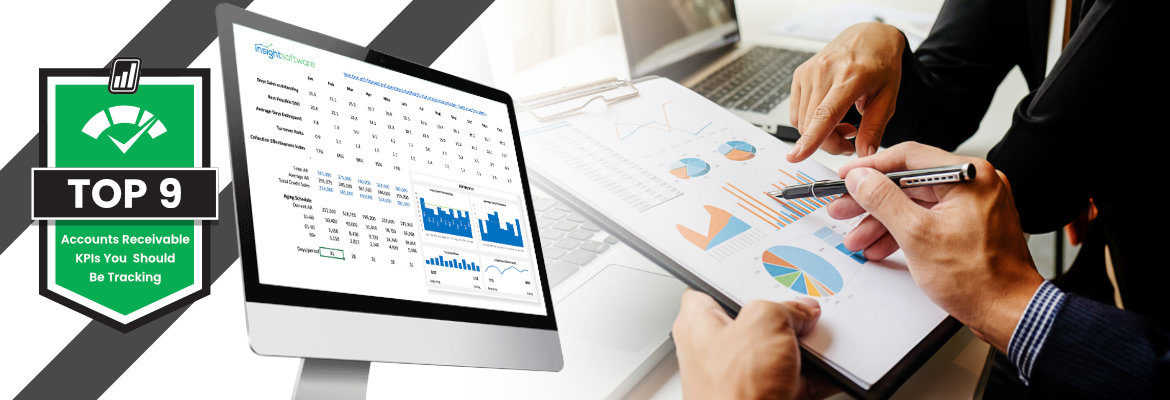The Top 9 Accounts Receivable KPIs You Should Be Tracking

Tracking the performance of your accounts receivable helps your financial organization understand what’s working well and what needs improvement. Monitoring your accounts receivable metrics closely is the first step toward improving business performance.
However, there are dozens of accounts receivable KPIs. How should you choose which to track? The most relevant operational KPIs will vary from company to company, and they may also change over time, along with your business goals. A good rule of thumb is to focus on the metrics that bring performance into focus.
Top 9 Accounts Receivable Performance Metrics to Track
Here are some top accounts receivable KPIs that offer valuable insights into financial performance:
Days Sales Outstanding (DSO)
Accounts receivable must track how long it takes, on average, to collect payments. This metric is the most baseline performance metric there is, which is why almost everyone monitors it as part of financial reporting. Observing when DSO rises or falls also helps reveal how market forces affect payment times. According to a recent benchmarking survey by APQC, top-performing companies have a below 30 days, whereas low-performing companies have a DSO of 48 days or longer.
Average Days Delinquent
The average days delinquent metric indicates how many days on average payments are overdue. The goal is to get this number as low as possible by encouraging clients to pay quickly. If the number is high, it could point to problems within accounts receivable, or within the larger company. For example, if several payments are long overdue, you could be targeting the wrong customers, or your business could be suffering from understaffing.
Turnover Ratio
Companies commonly track this financial KPI to learn how often they convert accounts into cash over a set period, typically a year. It provides helpful insights into a company’s liquidity and cash flow while also indicating how effective the company is at collecting revenue. A high ratio suggests there are lots of open accounts and unrealized revenue, which could mean it’s time to reconsider credit or collection policies.
Collection Effectiveness Index (CEI)
Think of this accounts receivable KPI as a companion metric to the turnover ratio. However, instead of indicating how often accounts turn over, CEI shows how many accounts turn over. A higher number indicates that companies are collecting on most of their accounts. Tracking when and why CEI rises and falls helps companies move closer to collecting on 100 percent of their receivables.
Number of Revised Invoices
Invoicing is at the heart of accounts receivable, so it’s essential to track how often invoices have to be revised. If the number is trending upward, it could mean that your accounts receivable department needs additional support or that invoicing policies need revision. Ideally, companies would never have to revise invoices, which creates unnecessary delays in payment.
Staff Productivity
Organizations with large accounts receivable staff invest heavily in labor costs to bring in revenue. Get a better picture of how effective that investment is by tracking the productivity of staff individually and collectively. Track the number of receipts processed per accounts receivable full-time employee, and the number of active accounts per credit/collection full-time employee.
Bad Debt to Sales Ratio
As a measure of the unpaid invoices compared to total sales, this metric sounds simplistic, but not for companies that know how to interpret it. Companies want to keep this number low, but they don’t necessarily want to eliminate or actively minimize bad debt either. A low number means companies are avoiding losses, but they’re also avoiding taking credit risks, which could mean they’re losing sales. Loosening up credit terms might lead to more unpaid invoices, but those may represent a fraction of the potentially increased sales.
Percentage of Credit Available
Accounts receivable departments that cap the amount of credit they extend should track what percentage of that credit customers leverage, both individually and as a collective average. If the percentage is high yet customers routinely pay in full and on time, it’s worth considering raising the credit limit, or doing the opposite when customers abuse credit privileges.
Percentage of High-Risk Accounts
Doing business with a high percentage of high-risk customers could lead to rising amounts of bad debt. Alternatively, low tolerance for risk may make it harder to grow sales. Define what a high-risk account looks like, then group together existing and incoming accounts that meet these criteria. Knowing the percentage of high-risk accounts gives important context to the question of what’s driving accounts receivable performance.
Track It All with Business Dashboards
The next step to improving accounts receivable performance is to implement dashboards to supplement the traditional financial reporting process. Once you start tracking the metrics that matter, those insights need to be available to all stakeholders across the organization quickly and easily. Dashboards provide users with an instant glimpse into accounts receivable performance by combining metrics, visualizations, and intuitive tools into one interface.
Get our Accounts Receivable dashboard template and customize it with your own data.

